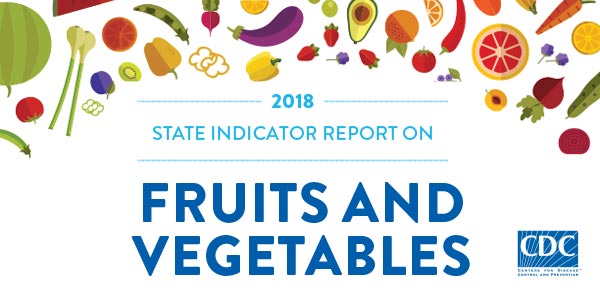At a glance
Eating a diet rich in fruits and vegetables can help protect against some diseases. However, few adults meet the recommended intake. This report highlights approaches to increase the purchase and supply of and demand for fruits and vegetables.

Background
Eating a diet rich in fruits and vegetables can help protect against serious and costly chronic diseases. Some examples include heart disease, type 2 diabetes, some cancers, and obesity. Despite the health benefits, Americans are not consuming enough fruits and vegetables in their daily diet. In 2015 and 2019, only about 1 in 10 adults met recommendations for fruit and vegetable intake.
The State Indicator Report on Fruits and Vegetables, 2018 highlights approaches to increase the purchase and supply of and demand for fruits and vegetables.
The report summarizes fruit and vegetable access for all 50 states and the District of Columbia. Fruit and vegetable access is measured by 10 indicators. The report also highlights state successes and provides strategies for improvement. Public health practitioners and decision-makers can use this report to quickly assess how their state is doing.
Potential state and community actions
- 31% of farmers’ markets in the United States help make fruits and vegetables affordable for low-income mothers and their children. They do this by accepting WIC Farmers’ Market Nutrition Program vouchers.
- Partner with diverse groups to increase access to fruits and vegetables. These partners can include schools, early care and education providers, local and state governments, and large employers. These partners are important because people eat in a variety of settings.
- 10 states have adopted a policy on food service guidelines that requires healthy foods and beverages, including fruits and vegetables, be sold or served in government worksites and on state owned or controlled property.
- 44% of middle and high schools have a salad bar in the school cafeteria.
- 42% of school districts in the United States participate in farm-to-school programs.
- Three states include national recommendations for serving fruits and vegetables in state early care and education licensing regulations.
- 10 states have adopted a policy on food service guidelines that requires healthy foods and beverages, including fruits and vegetables, be sold or served in government worksites and on state owned or controlled property.
- The 212 food hubs across the United States help small and mid-size farmers markets aggregate and distribute fruits and vegetables to local institutions. Examples of these local institutions include schools, hospitals, large employers, and retailers. Strengthening the local food system to support fruit and vegetable production and distribution benefits fruit and vegetable producers and consumers.
Downloads
2018 State Indicator Report on Fruits and Vegetables.
State Action Guides for all 50 states and the District of Columbia.
